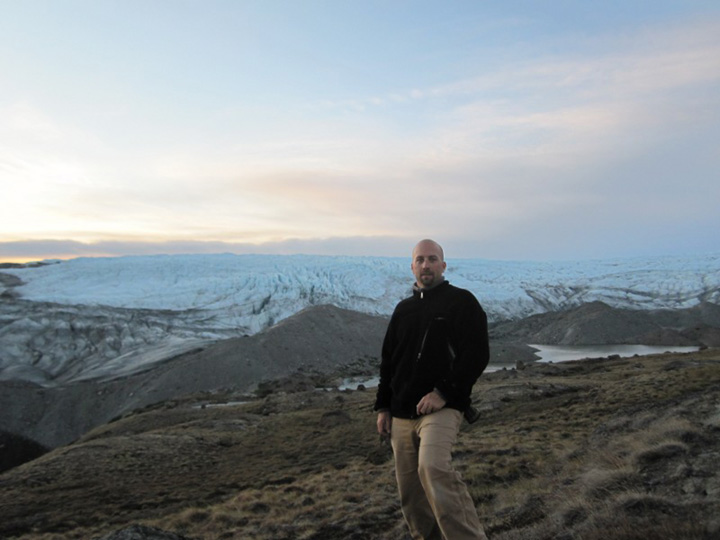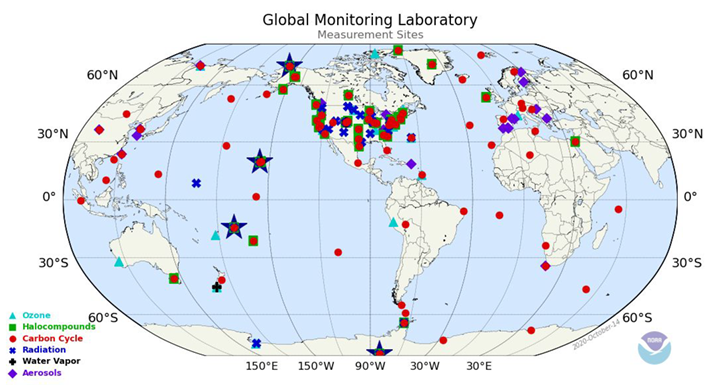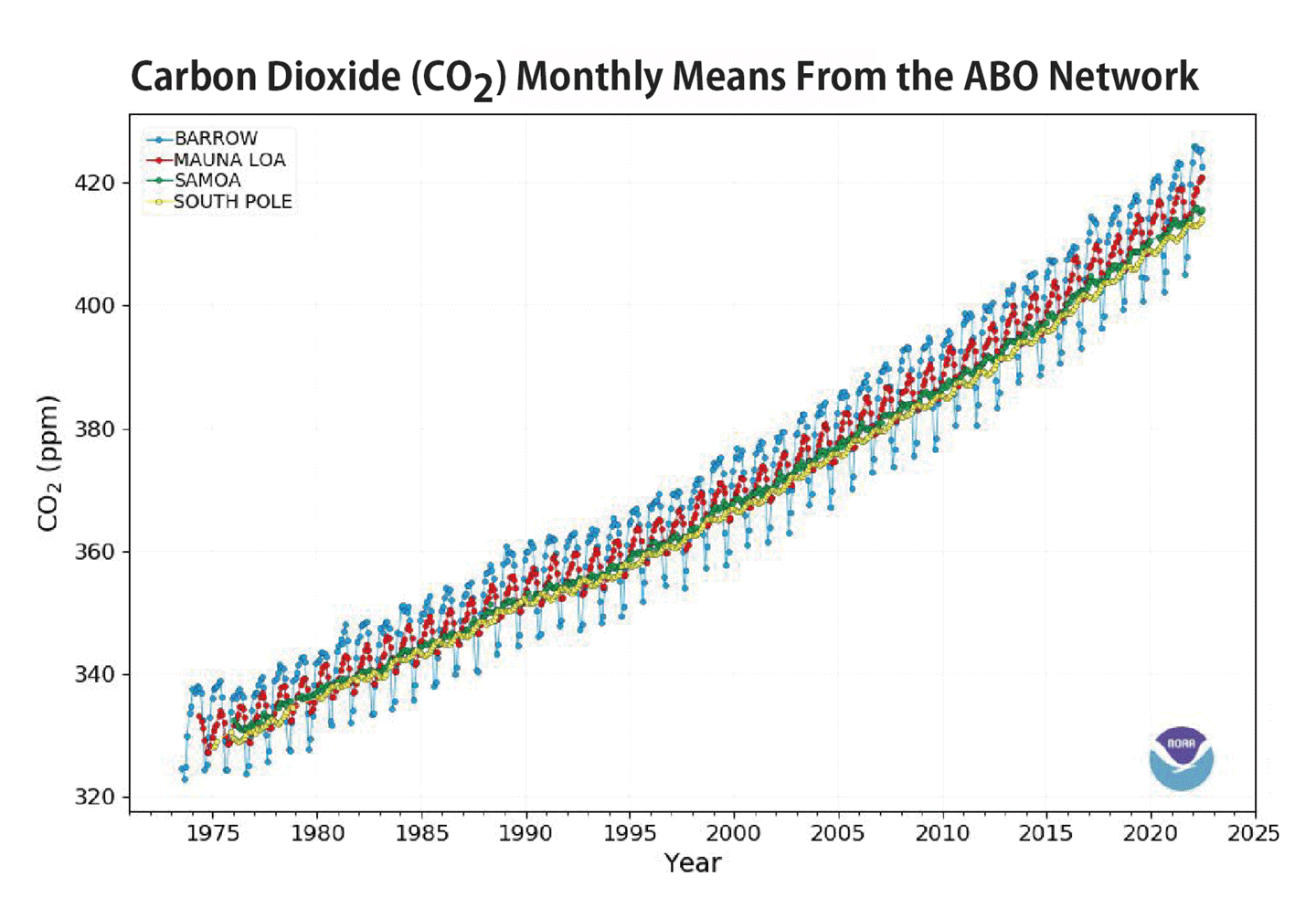NOAA Atmospheric Research Update

Thank you for the seminar opportunity to present about my career and home laboratory, The National Oceanic and Atmospheric Administration (NOAA) Global Monitoring Laboratory (GML). It was a pleasure to collaborate with so many wonderful researchers while at NIES for the month of September, 2023. This is a short review of my presentation with an overview of my background and some scientific highlights from NOAA GML.
My career with NOAA began in 1997 while still a student at the University of Colorado, Boulder working for the Climate Monitoring and Diagnostic Laboratory (CMDL) which was the predecessor organization to GML. In 2005, the NOAA Boulder laboratories were consolidated into the Earth System Research Laboratory and CMDL became the Global Monitoring Division. This organization lasted for ~15-years until 2020 when the four research Divisions in Boulder were renamed to be individual laboratories and the Global Monitoring Division became the Global Monitoring Laboratory.
After graduating from the University of Colorado with a degree in Environmental Biology, I was hired full-time with CMDL working in the stratospheric ozone research program launching weekly ozone-profile balloons and keeping CMDL’s network of ozone research stations supplied.
In 2002 I was given the opportunity to spend the austral winter season at South Pole Station, Antarctica as the NOAA instrument technician. I returned again and completed the 2003 winter as well. Each winter at the South Pole is ~9 months long and isolated from the rest of the world due to the air temperatures being too cold for aircraft to safely operate. After two 9-month long Antarctic winters, back-to-back, I returned to Boulder and CMDL to begin a new program measuring tropospheric ozone with aircraft profiles across North America. This role was challenging to develop instrumentation that could produce high-quality scientific data and also be small enough to easily integrate into light-aircraft such as Cessna-210 and the equivalent. At that time, the CMDL Carbon Cycle Research Team was beginning to build a network of light-aircraft for flask sampling and my role was to partner with the Carbon Cycle team to also install in-situ ozone instruments on the same aircraft. Over the next few years as this aircraft network was developed, I continued to deploy to the Antarctic each season to help facilitate the crew changes at South Pole as the NOAA technical lead. In total, I have deployed to the Antarctic 12 times, and similarly, well over a dozen trips to various research sites across the Arctic region (including Canada, Russia, Greenland, and the United States (Alaska)).
In 2007, I was asked to move over and officially work with the Observatory Operations team within CMDL and became the Field Operations Manager for NOAA’s network of four long-term Atmospheric Baseline Observatories (ABOs). The ABO sites span the Pacific basin from Barrow, Alaska in the north to Mauna Loa, Hawaii, American Samoa, and South Pole Station, Antarctica in the south. Since 2010, I have served as the Director of Observatories managing the ABO network and as a member of the laboratory’s overall senior-management team. In 2023, GML was reorganized internally and my role transitioned to be Director of Operations for GML. The new organization includes leading the operational components of GML’s long-term greenhouse gas measurements from aircraft, tall-towers, and surface flask sites in addition to the ABO sites, together forming the Observatory and Global Network Operations Division.
I am honored to have been selected as part of the 27th class of Mansfield Fellows working in Japan for one year (2023-2024). Each year, the Mansfield Fellowship Program selects 10 federal employees from across the U.S. government to spend 1-year in Japan working with colleagues from Japanese government agencies. The mission of the Fellowship Program is to build a collection of U.S. and Japanese government workers that understand one another and can continue to strengthen the connection between our two countries. As a Mansfield Fellow, I hope to connect Japanese and U.S. researchers involved in climate science with a particular focus on NOAA research, atmospheric sciences, and building ongoing collaboration.
NOAA GML has a long-term science mission based on three atmospheric themes: global greenhouse gas understanding and carbon cycle feedbacks, stratospheric ozone depletion, and understanding trends of surface radiation, clouds, and aerosols. These three research themes result in a global sampling network of over 100 sites in total and measurements on all seven continents.

In particular, I would like to briefly describe GML’s Global Greenhouse Gas Network which is made up of over 70 sites worldwide consisting of tall towers (7 sites), aircraft (14 sites) and an extensive surface flask (>55 sites). This network has been critical for capturing the global atmospheric burden of greenhouse gasses (GHGs), quantifying a first order estimate of changes in radiative balance due to GHG loading, and providing a very broad picture of emissions and the role that ecosystems play. GML has coupled this global collection of GHGs data with the CarbonTracker data assimilation system. While the CarbonTracker tool is quite useful to researchers around the world, this product is still extremely limited by the total amount of data that we have available for it. The NOAA GML sampling network is large, and yet, this valuable network still requires significant international partnership and collaborative measurements to be a truly powerful tool for the research and decision-making communities.
GML also serves as the World Meteorological Organization’s (WMO) Central Calibration Facility (CCL) and maintains the global scales for measurements of Carbon dioxide (CO2), Carbon monoxide (CO), Methane (CH4), Sulfur Hexafluoride (SF6), and Nitrous Oxide (N2O). GML has maintained this role since 1997 for the global community and currently has an archive with 100s of cylinders of standard gasses for over 55 different compounds. Global partners can purchase standards from NOAA (cost recovery only = no profit) to help calibrate partner-institution’s measurements onto the global WMO scale(s).
CFC-11 is the second most abundant ozone-depleting gas in the atmosphere. Production was banned beginning in 2010 and concentrations of CFC-11 peaked in the late 1990s before beginning to decline due to the Montreal Protocol. However, in 2018 the NOAA GML network detected a slowdown in the decline of CFC-11 in the atmosphere. This slowdown pointed to a potential breach of the Montreal Protocol and placed doubts onto the timeline for recovery of the stratospheric ozone layer. Approximately 50% of the slowdown was attributed to emissions from China and following international pressure from the United Nations the emissions decreased. As a result, the global decline of CFC-11 is again matching the expected rates and potential loopholes in the Montreal Protocol have been corrected for the future. This recent CFC-11 story is a great example of why long-term records are so valuable and demonstrates how these measurements not only document the atmospheric burden and growth rates of a particular gas for scientific purposes, but also for decision-makers at the highest international levels.
NOAA GML has been conducting aircraft GHG measurements from light-aircraft for ~2 decades at specific locations around the United States. Recently, however, the need for additional measurements at a larger scale and frequency across North America are needed to better understand the carbon cycle. GML has been working with Alaska Airlines and Boeing Corporation to test inlet designs and measurement viability on 737 aircraft. The 737 aircraft were targeted for a few reasons, one, that is the primary aircraft in the Alaska Airlines fleet and two, because the NOAA National Weather Service has been using a flush mount inlet (FAA approved) on 737 flights to collect water vapor data for multiple years with a proven success rate. After testing multiple inlet configurations during a partnership project with Boeing called the EcoDemonstrator, NOAA has decided to pursue a commercial aircraft program with Alaska Airlines using the flush mount inlet design.
Related to this increased aircraft work, GML has also identified large geographic areas, such as Africa, that are sparsely sampled. During the COVID pandemic, GML worked with a small aircraft company in Uganda to help address this gap in measurements. The project successfully installed and flew missions in tropical Africa capturing more than 200 vertical profiles between 0-4 degrees North latitude in Uganda. This data set captures large scale GHG enhancements, impacts of fires, and wet/dry seasonality. The aircraft sampling in Africa is ongoing, however, the aircraft is no longer based in Uganda and new flights elsewhere in Africa are currently in the planning process.
Finally, I would like to quickly discuss the impacts of the November, 2022 eruption of Mauna Loa Volcano on the NOAA Mauna Loa Observatory (MLO). Situated at 3,397m on the north flank of Mauna Loa, the MLO site is often considered one of the most important atmospheric science facilities in the world and famous for being the home of the iconic ‘Keeling Curve’ documenting the continued rise of atmospheric CO2.

The MLO facility is accessed by a 29-km driveway that runs directly below the volcano’s rift zone. After a 38-year lull in eruptions, the volcano began to flow lava again late in the evening of November 27th. By 4pm the next day, November 28th, the lava had crossed the MLO access road and severed the power lines to the facility. The eruption lasted for 16 days and lava crossed the road in 2 different locations, covering a total of ~1.5km of roadway, and at depth of 10m in many places. The observatory also lost over 60 power poles over that same distance.
NOAA responded by first establishing measurements at the summit of Mauna Kea (a neighboring volcano) in partnership with the University of Hawaii. The University runs multiple telescopes at the summit of Mauna Kea, situated at ~4,200m, and agreed to allow NOAA to install some in situ measurements on December 8th (operational 10 days after the eruption began). In addition, once the eruption concluded and air quality improved enough to safely access to MLO, NOAA flew staff to the facility by helicopter on December 21st (8 days after the eruption officially concluded). To date, NOAA is still accessing the site once per week via helicopter and plans are in place to re-establish road access in the coming months as the lava cools and the repair work can be safely engineered and completed. Prior to the eruption, the MLO facility had solar panels installed on two of the main buildings, however, these panels were connected directly into the electrical grid at the observatory. Following the eruption, these panels were not operational since the utility line was lost and grid power did not exist at the site. NOAA worked with a construction partner to bring additional solar panels and a battery solution to MLO via helicopter to begin to power on some of the science projects. Approximately 33% of the science at MLO is currently operating in a limited capacity model. Once road access is re-established, construction plans include facility updates that are long overdue and a significant investment into the power infrastructure and renewable energy.
Thank you for the opportunity to present a short overview of NOAA GML science and facilities. I look forward to working with the NIES team in the coming years to strengthen our collaboration efforts and further our collective understanding of climate change. I have no doubt we can do more as partners. As the renowned Japanese poet, Ryunosuke Satoro said, "Individually we are one drop, but together we are an ocean".
ありがとうございました。

